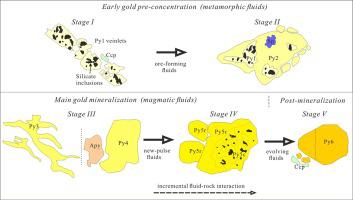Ore Geology Reviews ( IF 3.3 ) Pub Date : 2022-09-09 , DOI: 10.1016/j.oregeorev.2022.105093 Xing-Hui Li , Hong-Rui Fan , Hai-Lin Xie , Kui-Feng Yang , Pete Hollings , Zhan-Hao Wei , Ri-Xiang Zhu , Qing-Dong Zeng , Gai-Zhong Liang , Jin-Jian Wu

|
The Tanjianshan goldfield is the most important gold producer in the North Qaidam, NW China. Genesis of gold deposits in Tanjianshan is enigmatic, primarily because of uncertainties as to timing, mineralization processes and fluid sources. We investigate these uncertainties through a comprehensive study of the texture and geochemistry (LA-MC-ICPMS trace elements and sulfur isotopes) of pyrite and in-situ U-Pb dating of monazite from the Qinglonggou gold deposit. Six types of pyrite with distinct textures, trace element contents and sulfur isotopes have been identified, and provide constraints on two overprinting gold-related hydrothermal events. Stage I consists of Py1, occurring as veinlets parallel to S1 deformation in a schist, is characterized by extremely low Co/Ni ratios with high contents of Ni, and high δ34S values (+14.9 ‰ to +16.1 ‰), and were likely derived from metamorphism of the sedimentary strata in the Tanjianshan and Wandonggou Group. In stage II, Py2 occurs in the pyrite-quartz veins that cut Py1 veinlets. They have similar δ34S (+13.1 ‰ to +17.8 ‰) to Py1, indicating that sulfur was likely derived from the dissolution of Py1. The stage I and II veins formed during an early gold pre-concentration event, which is constrained at 429.1 ± 5.9 Ma by in-situ U-Pb dating of monazite that coexists with Py1. Stage III includes Py3 and Py4 which occur in the altered carbonaceous schist and accompanying quartz veins. Trace metals are highest in Py3 (Ag, Au, Sb, and Bi) which represent the most economic ore stage in the deposit, whereas the following Py4 shows low concentrations of most trace elements due to abundant Py3 precipitation. In contrast, trace elements contents increase in Py5 to similar levels as those seen in Py3, suggesting a new pulse of fluid in stage IV. Minor Py6 grains precipitated in the youngest quartz-calcite veins associated with stage V, and contain low concentrations of trace elements. The δ34S values of Py3 (+5.2 ‰ to +6.0 ‰) and Py4 (+4.2 ‰ to +6.1 ‰) are within the range of magmatic sulfur, suggesting a dominantly magmatic source. The δ34S values increase from Py3-4 to Py5 (+6.3 ‰ to +7.4 ‰), and to Py6 (+8.7 ‰ to +9.6 ‰), probably due to increasing contribution from the host rocks, as well as decreasing fO2, through incremental fluid-rock interaction. Stages III and IV represent a late gold-mineralizing event during Late Paleozoic to Early Mesozoic, while stage V is post-mineralization. The overprinting gold pre-concentration and mineralization events in the Tanjianshan goldfield correspond to orogenic evolution of the Proto-Tethys Ocean and Paleo-Tethys Ocean, respectively.
中文翻译:

柴北青龙沟金矿的年代学、成矿过程和流体来源:独居石原位U-Pb定年和黄铁矿地球化学的约束
谭剑山金田是柴达木北部最重要的黄金产地。谭剑山金矿成因难以捉摸,主要是因为时间、成矿过程和流体来源的不确定性。我们通过对黄铁矿和原位的质地和地球化学(LA-MC-ICPMS 微量元素和硫同位素)的综合研究来调查这些不确定性青龙沟金矿独居石U-Pb定年[J]. 已经确定了六种具有不同质地、微量元素含量和硫同位素的黄铁矿,并为两种与金相关的热液叠印事件提供了限制条件。第一阶段由 Py1 组成,在片岩中以平行于 S1 变形的细脉形式出现,其特点是极低的 Co/Ni 比和高 Ni 含量,以及高 δ 34 S 值(+14.9 ‰ 至 +16.1 ‰),并且是可能来自于潭尖山和万东沟群沉积地层的变质作用。在第二阶段,Py2 出现在切割 Py1 细脉的黄铁矿-石英脉中。它们具有相似的 δ 34S (+13.1 ‰ to +17.8 ‰) 到 Py1,表明硫很可能来自 Py1 的溶解。I期和II期矿脉形成于早期的金预富集事件,原位限制在429.1±5.9 Ma与 Py1 共存的独居石 U-Pb 测年。第三阶段包括 Py3 和 Py4,它们出现在蚀变的碳质片岩和伴随的石英脉中。痕量金属在 Py3(Ag、Au、Sb 和 Bi)中含量最高,代表了矿床中最经济的矿石阶段,而以下 Py4 显示由于 Py3 沉淀丰富,大多数痕量元素浓度较低。相比之下,Py5 中的微量元素含量增加到与 Py3 中相似的水平,这表明在 IV 阶段出现了新的流体脉冲。与第 V 期有关的最年轻的石英-方解石脉中沉淀出少量 Py6 晶粒,含有低浓度的微量元素。Py3(+5.2‰至+6.0‰)和Py4(+4.2‰至+6.1‰)的δ 34 S值在岩浆硫范围内,表明主要为岩浆源。δ34 S 值从 Py3-4 增加到 Py5(+6.3 ‰ 到 +7.4 ‰)和 Py6(+8.7 ‰ 到 +9.6 ‰),可能是由于主岩贡献增加以及f O 2降低,通过增量流体-岩石相互作用。第三和第四阶段代表晚古生代至早中生代的晚期金矿化事件,而第五阶段是矿化后。谭剑山金田的套印金预富集和成矿事件分别对应于原特提斯洋和古特提斯洋的造山演化。



























 京公网安备 11010802027423号
京公网安备 11010802027423号